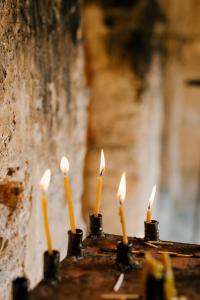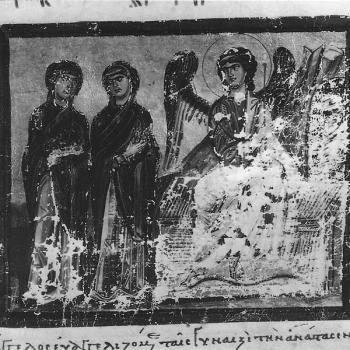Do you enjoy the world of trivia? If you’re anything like me, a good trivia game is both exciting and interesting. Learning various facts through the world of trivia tend to stick with us and pop up in conversations later in time. This is also true as people of faith in the world of Christian trivia.
Personally, I love Christian trivia – facts of the faith we can drop here and there that help others to learn more about their faith as well as the faith of others. In honor of National Trivia Day (January 4), I present to you Christian trivia – several different tidbits of faith you may not already know – that are perfect for a trivia night or to drop as facts in everyday conversation!

The term “Christian” was first used at Antioch
Have you ever wondered what the first Christians called themselves? They weren’t called “Christians.” They were, most likely, known as “followers of the Way.” In the year 44 (approximately 11 years later), they were first called Christians in Antioch:
…The disciples were called Christians first at Antioch. (Acts 11:26, NIV)
The church at Antioch was special because it was the first all-Gentile church. It came into being in modern-day Antakya, Turkey through the missionary efforts of the Apostles Paul and Barnabas. These two spent a year with the community. While the two were in Antioch, the community of believers were described as “Christian” for the first time.
The term “Christian” means “little Christ.” Originally used pejoratively, the term was one of contempt. By saying believers were “Christian,” the pagans of Antioch were saying Christians were small, or meaningless, in nature. If they only knew how Christianity would change the world!
Members of Caesar’s household were Christians
Though deliberately vague, Philippians 4:22 says: All God’s people here send you greetings, especially those who belong to Caesar’s household. (NIV) Though we don’t know who these individuals were, it’s likely they were people who worked as slaves, clerks, in finance (especially at Ephesus), or in governing departments.
The early church didn’t celebrate Christmas or Easter
Today it seems like the entire world – both Christian and non-Christian – celebrate Christmas and Easter. With a blend of cultural, contemporary, and religious ideas, Christmas and Easter appear to be staples on the seasonal calendar. Believe it or not, this wasn’t always the case!
Neither Christmas nor Easter were part of early church Christianity. The first Christians observed the Passover, while no one acknowledged Christ’s birth. Somewhere in the second century, we find reference to a resurrection service. Even then, widespread celebration of what we now know as Easter wasn’t common. It wouldn’t be until the third century – and Constantine’s intervention – that Christmas and Easter would become Christian observances.
There were Christians in China in the seventh century
The Church of the East (also known as the Nestorian Church) successfully evangelized China under the Tang Dynasty (618-907). We find this history on the Nestorian Stele, a limestone block detailing 150 years of Christianity in China. Written in Chinese and Syriac, it tells of several Christian communities in northern China. The stele dates around 781 and offers the history of Alopen, who came evangelize China with Syriac missionaries. Christian persecution forced the stele underground, and it was buried around 845. It was discovered in 1625 and is now in the Stele Forest, a museum in Xi’an, China.
The oldest church in the world was a house!
There are disputes over what constitutes the “oldest church in the world.” However, most cite the oldest church to be the Dura-Europos Church, located in east Syria. This church dates to around 235 AD. It was first a house, and later a church building. More than likely, it was a private home used for home church services before it became a church. This tells us, if nothing else, that homes were still central meeting places for believers after the first century. Along with the church archaeologists discovered a series of frescoe paintings. These are among the earliest Christian paintings ever found.
The cross wasn’t the original Christian symbol
The Ichthys, or “fish symbol” is a popular Christian symbol. Today, we see it on jewelry, stickers, Bible covers, books, and in other designs. Did you know it was also the most prominent symbol of the early church? Used as a secret symbol (it helped Christians identify one another during persecution), it’s found on tombstones, catacombs, and on the walls of meeting places dating to the second century. The symbol represents Christ’s call to be “fishers of men” (Matthew 4:19) and the many times He used fish as part of a miracle, illustration, or meal (Matthew 12:38-45, Matthew 13:47-50, Matthew 14:13-21, Matthew 17:24-27, Mark 6:31-44, Luke 9:12-17, Luke 24:41-43, John 6:1-14, John 21:11). The Greek form of Ichthys forms an acronym, which spells out “Jesus Christ, God’s Son, Savior.”
Jacob’s Well still exists
Jesus’ longest dialogue wasn’t with Peter, James, or John. It was with the Samaritan woman, in John 4. The two spoke at Jacob’s Well, a watering spot in modern-day Tell Balata (thought to be the Biblical site of Shechem). Here, Jesus spoke with a woman (identified as Photini in early church history) who would share this encounter with her people. Identified as an apostle, Photini was the first apostle to the Gentiles, starting a long history of female leadership in Christianity.
Photini’s legacy forever connects to this well. It stands as a memorial of her legacy as both a believer and a Christian leader. Believe it or not, this landmark is now in the crypt of a Greek Orthodox Church at Nablus, Palestine. More than 40 meters deep, Jacob’s Well is considered the most authentic site in the Holy Land.
There are still nations where it is dangerous to be a Christian
Christianity remains a controversial belief system in some nations, even to this day. In some countries, Christians face persecution or death. Churches exist in homes, without advertisement or promotion of events. Christians cannot share their faith in many of these nations, as well. The most dangerous nations for Christians include:
- Afghanistan
- North Korea
- Somalia
- Libya
- Yemen
- Eritrea
- Nigeria
- Pakistan
- Iran
- India
In a more interesting turn, it’s possible to live in places where people don’t know any Christians. There are so few in these areas, only small percentages of the population have ever met a Christian. These areas include:
- Afghanistan
- Mayotte
- Mauritania
- North Korea
- Algeria
- Western Sahara (Morocco, Sahrawi Arab Democratic Republic)
- Somalia
- Turkey
- Yemen
- Iran
Christian trivia can be fun!
Christian trivia about the history of our faith – from past to present – can prove a fun way to learn more about the experiences of believers throughout the ages. What are some of your favorite Christian trivia tidbits? Be sure to drop them in a conversation, game, or event sometime soon!














